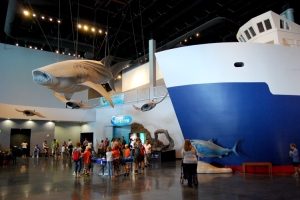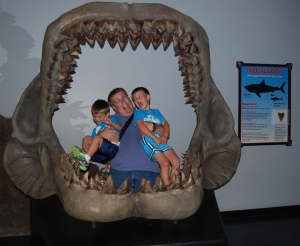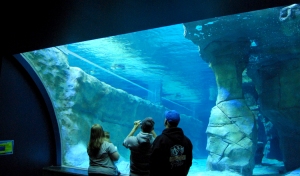I’ve watched this aquatic zoo grow from a storefront space in a downtown mall to a rehabilitated strip mall building and now to its brand new facility on the side of the freeway. Though the space is greatly improved and the aquarium succeeded in several areas, there is still room for improvement and growth.
While in Utah a few weeks ago, I took the opportunity to visit the new Loveland Living Planet Aquarium with my nephews and nieces. It was exciting since I really enjoy aquariums. You enter the building with glimpses of the rainforest exhibit to your right, which got me really excited. One opportunity I feel they missed was the journey to the entrance was void of any sign you’re entering an aquarium other than the literal sign on the side of the building. This entrance plaza is the perfect place to get people engaged before they even go through the doors.
 Inside is a massive open space with the several exhibit entrances around the giant foyer. This was the first sign of not having the greatest use of space. However, some of the exhibit stuff in the main lobby is fun including a set of megalodon jaws, whale sculptures overhead, a giant ship and an area with orcas to climb on for pictures and such. The entrance to each exhibit was also well designed with a massive jungle-like tree leading to the rainforest and red sandstone cliffs to the Utah exhibit.
Inside is a massive open space with the several exhibit entrances around the giant foyer. This was the first sign of not having the greatest use of space. However, some of the exhibit stuff in the main lobby is fun including a set of megalodon jaws, whale sculptures overhead, a giant ship and an area with orcas to climb on for pictures and such. The entrance to each exhibit was also well designed with a massive jungle-like tree leading to the rainforest and red sandstone cliffs to the Utah exhibit.
 Our first stop was the ocean because this is where the touch tank is. You have all of your standard aquarium fish in the ocean exhibit and a good size touch tank (though very hard for kids to really reach over and touch something). I noticed that the tanks are all very bland right now with just rock walls. I’m not sure if they will have corals or sea grasses or anything soon, but it looked kind of boring and incomplete.
Our first stop was the ocean because this is where the touch tank is. You have all of your standard aquarium fish in the ocean exhibit and a good size touch tank (though very hard for kids to really reach over and touch something). I noticed that the tanks are all very bland right now with just rock walls. I’m not sure if they will have corals or sea grasses or anything soon, but it looked kind of boring and incomplete.
There is the essential shark tunnel as well. I loved that this tunnel led to a room with large viewing windows to see into the same tank, so you got a view of the creatures from more angles. It was one of the better uses of space in the aquarium.
After this, I explored the rainforest. I was expecting a lush jungle of a space with many exhibits, flying birds and more, like at my favorite Dallas World Aquarium, but that’s not exactly what I found. The space is a large glass room with a walkway that meanders and leads up a ramp to a second level. The space has some nicely sculpted rock walls and jungle size tree trunks.
There is also lots of real foliage, which has yet to grow and fill in the spaces. I’m sure this will happen. But it seems like the tropical foliage used was just picked from a nursery by someone who hasn’t studied the rainforest or been to one. The plants come from many tropical places and don’t necessarily belong in the same ecosystem as if the aquarium is trying to tell the story of all the world’s rainforests in one mash-up exhibit.
There were tanks scattered about the space with some streams. One space had a couple of ducks, another had toucans. The only free-flying birds were some little cardinals. The space wasn’t that big, so I was up the ramp before I knew it. At the second level is an attraction that seemed more popular than the animals—a rope bridge.
In a corner behind this bridge were some of the best curated amphibian displays I’ve seen. They were large and lushly planted with several varieties of frog to watch.
 From the second level of the aquarium where we exited the rainforest, we took the ramp down to the penguin exhibit, which was one of the biggest penguin exhibits I’ve ever seen with more room for the birds to swim and waddle than many others. It also has a unique viewing window, half of a standard aquarium tunnel (a quarter pipe?), that lets you stand under the water where the birds dart through the freezing water. To get out of the penguin exhibit there is another long ramping corridor.
From the second level of the aquarium where we exited the rainforest, we took the ramp down to the penguin exhibit, which was one of the biggest penguin exhibits I’ve ever seen with more room for the birds to swim and waddle than many others. It also has a unique viewing window, half of a standard aquarium tunnel (a quarter pipe?), that lets you stand under the water where the birds dart through the freezing water. To get out of the penguin exhibit there is another long ramping corridor.
What I found so astonishing was the lack of anything in the hallways leading to and from the penguins. This was lots of usable square footage with neither tanks in the walls or educational information or anything, but just darkened walking paths. It really seemed like a waste of space or a very poor use of space especially for a nonprofit that should responsibly use every square inch it has to accomplish its mission and use its precious funds so generously given by donors.
I think the next section of the aquarium was my favorite. It was the Utah section. This was the only unique area of the aquarium that you won’t find anywhere else, and they did a great job of it. If only it had been bigger. You enter this exhibit through a red rock slot canyon with stone arches like you find all over the southern end of the state. Here you’re greeted by some scaly Utahns. We then get to a small enclosure for the endangered desert tortoise. Eventually, we learn what fish live in the mountain streams and see waterfalls and ponds with waterfowl.
The crowning moment in this exhibit are the river otters. These playful critters have a large enclosure with a stream running through it with waterfall and more. The stream even goes outside, so these native animals can experience both the controlled and uncontrolled Utah environment. Just like the penguins, the otter space was bigger than any I’ve seen before.
I recommend a visit to this aquarium. It has some very high points and others just okay. It is no Monterey Bay Aquarium, Tennessee Aquarium, or Dallas World Aquarium, but it does offer a fun get away and glimpse into nature.
(In a following post I will share my opinion on how the aquarium could have hit a grand slam instead of a single or double.)




Focusing to Excel | Adventure Patches
[…] the Living Planet Aquarium in Salt Lake City has done a good job, as I mentioned in the last post. I just think they needed to focus and do one thing better than anyone else, make it perfect then […]